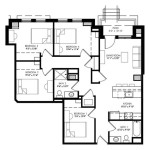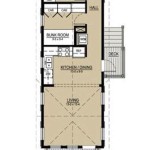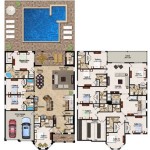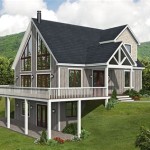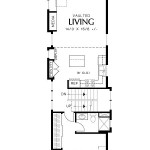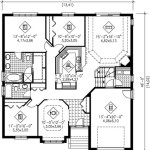Mother-In-Law Floor Plan Houses: A Comprehensive Guide
Mother-in-law floor plan houses, also known as accessory dwelling units (ADUs), in-law suites, or multi-generational homes, are residential designs incorporating a self-contained living space within a larger residence. These layouts offer flexibility and independence for multiple generations or occupants while maintaining proximity and shared resources. The popularity of these designs has increased significantly due to factors such as rising housing costs, aging populations, and a desire for closer family connections.
The core concept of a mother-in-law floor plan revolves around providing a private, functional living area separate from the main living quarters. This often includes a bedroom, bathroom, kitchenette or full kitchen, and a separate living area. Access can be internal through a connecting door or external via a private entrance, allowing for varying degrees of interaction and privacy. The design aims to strike a balance between shared living and independent existence.
Defining Characteristics of a Mother-In-Law Floor Plan
The defining characteristics of a mother-in-law floor plan go beyond simply adding an extra bedroom and bathroom. The key is the creation of a truly self-contained unit, capable of supporting independent living. This section will delve into the essential elements that distinguish these floor plans from regular houses with extra bedrooms.
Separate Entrance: A dedicated entrance is crucial for maintaining privacy and independence. This can be a side door, a back door, or even a separate front door, depending on the design and zoning regulations. A separate entrance allows residents of the in-law suite to come and go without disturbing the main household, fostering a sense of autonomy.
Private Living Area: The suite must have its own dedicated living space, separate from the main living room or family room of the primary residence. This area serves as a place for relaxation, entertainment, and personal activities for the occupant of the suite. The size and layout of the living area will vary depending on the overall size of the in-law suite and the needs of the intended resident.
Independent Kitchen or Kitchenette: A fully functional kitchen or at least a kitchenette is a necessity. A full kitchen will typically include a stove, oven, refrigerator, sink, and ample counter space. A kitchenette, on the other hand, might consist of a smaller refrigerator, microwave, sink, and limited counter space. The choice depends on the level of independence desired and the available space.
Private Bathroom: A private bathroom is essential for comfort and convenience. It should include a toilet, sink, and shower or bathtub. Accessibility features, such as grab bars and a walk-in shower, may be considered, especially if the suite is intended for elderly residents or individuals with mobility challenges.
Bedroom: A dedicated bedroom is a fundamental component of a mother-in-law floor plan. The size of the bedroom should be adequate for a comfortable bed, storage furniture (such as a dresser or closet), and personal belongings. It is advisable to incorporate features that maximize natural light and ventilation.
Considerations for Accessibility: When designing a mother-in-law suite, focusing on accessibility is often prudent. This might involve wider doorways and hallways to accommodate wheelchairs or walkers, grab bars in the bathroom, and lever-style door handles. Universal design principles can enhance the comfort and usability of the space for individuals of all ages and abilities.
Advantages of Owning a Mother-In-Law Floor Plan House
Investing in a mother-in-law floor plan house can provide numerous benefits, extending beyond the immediate need for accommodating family members. These advantages impact finances, lifestyle, and long-term property value. This section examines the various benefits associated with these home designs.
Multi-Generational Living: The primary benefit is facilitating multi-generational living arrangements. This allows families to care for aging parents while maintaining their independence and privacy. It also provides grandparents with the opportunity to be actively involved in the lives of their grandchildren. The proximity fosters stronger family bonds and shared experiences.
Rental Income Potential: If the in-law suite is not immediately needed for family members, it can be rented out to generate income. This can help offset mortgage costs or provide supplemental income. However, it is critical to thoroughly research local zoning regulations and rental market conditions before committing to this strategy.
Increased Property Value: A well-designed and maintained mother-in-law suite can increase the overall value of the property. This is because it adds usable square footage and caters to a growing segment of the population seeking multi-generational living options or rental income opportunities. The appeal of a flexible living space can be a significant selling point.
Caregiving Support: Having a family member residing in the in-law suite can provide peace of mind, especially if they require assistance with daily tasks. It makes it easier to provide care and support while still maintaining a sense of personal space and privacy. This can be particularly beneficial for families with elderly or disabled members.
Flexibility and Adaptability: The in-law suite can be adapted to various purposes over time. It can serve as a guest suite, a home office, a studio, or even a space for adult children returning home. This adaptability makes the property more versatile and responsive to changing needs and circumstances.
Financial Benefits: Beyond rental income, there might be other financial advantages. Sharing expenses, such as utilities, can lead to cost savings. Additionally, certain tax deductions or credits may be available for homeowners providing care for elderly family members. It is advised to consult with a tax professional to explore these possibilities.
Important Considerations Before Purchasing or Building
Before purchasing or building a house with a mother-in-law floor plan, careful planning and research are essential. This includes researching local zoning regulations, considering the needs of the intended occupant, and budgeting for construction or renovation costs. Overlooking these considerations can lead to complications and dissatisfaction.
Zoning Regulations: One of the most critical steps is to verify local zoning regulations regarding accessory dwelling units (ADUs). Many municipalities have specific rules regarding size, setbacks, parking, and other requirements. Failure to comply with these regulations can result in fines or even the forced removal of the in-law suite. It is best to consult with the local planning department before proceeding with any purchase or construction.
Building Codes: Ensure that the in-law suite complies with all applicable building codes. This includes requirements for electrical wiring, plumbing, fire safety, and structural integrity. Hiring licensed and insured contractors is essential to guarantee that the work is done to code and meets safety standards.
Privacy and Noise: Consider the level of privacy desired for both the main residence and the in-law suite. Strategic placement of the suite, soundproofing measures, and landscaping can help minimize noise and visual disturbances. Separate entrances and outdoor spaces further enhance privacy.
Accessibility Needs: If the in-law suite is intended for elderly or disabled residents, it is essential to incorporate accessibility features. This includes wider doorways, grab bars, ramps or elevators, and accessible bathrooms and kitchens. Planning for these needs early in the design process can prevent costly modifications later on.
Budgeting: Accurately estimate the costs associated with purchasing, building, or renovating a house with a mother-in-law floor plan. This includes not only construction costs but also permit fees, design fees, landscaping costs, and potential increases in property taxes. Obtain multiple bids from contractors and plan for contingencies to avoid unexpected expenses.
Long-Term Planning: Consider the long-term needs and goals for the property. Will the in-law suite always be used for family members, or will it eventually be rented out? How might the needs of the residents change over time? Thinking about these factors will help ensure that the design is flexible and adaptable to future circumstances.
Legal Agreements: In multi-generational living situations, it is often advisable to establish clear legal agreements regarding financial responsibilities, property ownership, and dispute resolution. This can help prevent misunderstandings and conflicts down the road. Consulting with an attorney is recommended.
In conclusion, mother-in-law floor plan houses offer a flexible and valuable housing solution for a variety of needs. By carefully considering the defining characteristics, advantages, and important considerations, individuals can make informed decisions about incorporating this type of design into their living arrangements.

Homes With Mother In Law Suites

In Law Suite Plans Give Mom Space And Keep Yours The House Designers

Small Mother In Law Suite Floor Plans Home Design Cottage Apartment House

Mother In Law National Home Builders

Mother In Law Suite Floor Plans Resources

6 Bedroom Country Style Home With In Law Suite The Plan Collection

Exclusive Brick Clad House Plan With Mother In Law Suite 510210wdy Architectural Designs Plans

French Country In Law Suite House Plan Home 153 1491

House Plans With In Law Suite Floor Designs

Spacious House Plan With Mother In Law Suite 3568 Sq Ft 5906nd Architectural Designs Plans

